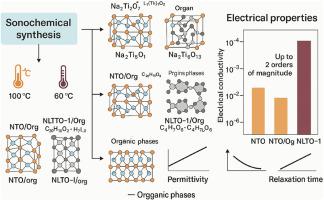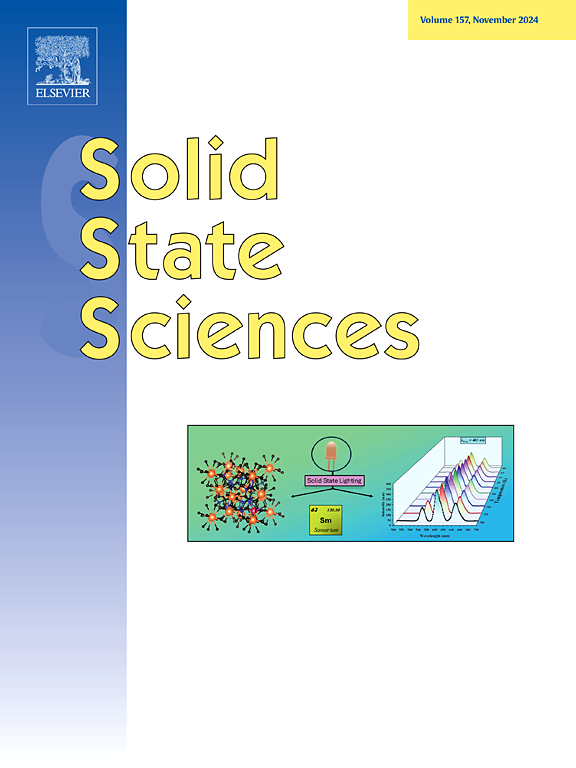Synergistic effects of lithium doping and organic phases on the electrical and dielectric properties of sodium titanate solid-state electrolytes
IF 3.3
3区 化学
Q2 CHEMISTRY, INORGANIC & NUCLEAR
引用次数: 0
Abstract
Energy storage technologies have attracted widespread attention due to the growing global demand. In this context, we present a detailed study of the structural, electrical, and dielectric properties of sodium titanate samples, with Na2Ti3O7 as the predominant crystalline phase and Na2Ti6O13 as the secondary phase, following lithium addition. Additionally, the synthesis route also produced samples capable of retaining organic phases, derived from the solvents used, even after thermal treatment at 900 °C. The above materials were characterized using X-ray diffraction (XRD) with Rietveld refinement, scanning electron microscopy (SEM), Fourier transform infrared spectroscopy (FTIR), complex impedance spectroscopy, distribution of relaxation times analysis (DRT), and density-functional calculations. In samples with retained organic phases, the presence of C20H10O2 was observed in the sample without lithium addition, whereas, lithium hydrogen maleate (C4H7LiO6) and C20H10O2 were detected in the sample on lithium addition. Density functional analysis was performed to obtain detailed information on the various phases. Moreover, the gap values of the phases demonstrated an increase in conductivity due to the presence of the organic phases. Scanning electron microscopy revealed a morphology already known for sodium titanate. It is characterized by uniform rod-like structures, with particle sizes ranging between 1 μm and 2 μm in samples without organic phases. In contrast, samples with organic phases exhibited a distinct morphology, with low uniformity and significant variations in particle sizes. FTIR spectroscopy revealed the predominance of bands below 920 cm−1, characteristic of Ti – O, Ti – O – Ti, and Na – O bonds. Furthermore, complex impedance spectroscopy revealed a two- order-of-magnitude increase in conductivity for the 1 % lithium sample containing organic phases, compared to the pure ceramic sodium titanate sample. Dielectric analysis reveals a synergistic effect between lithium incorporation and organic phase retention, leading to enhanced energy storage capacity. Distribution of relaxation times (DRT) analysis shows strong agreement with the equivalent circuit models obtained via ZView software from the complex impedance data. The above results confirm the feasibility of the use of sodium titanate in solid-state electrolytes.

锂掺杂与有机相对钛酸钠固态电解质电性能和介电性能的协同效应
由于全球需求的增长,储能技术引起了广泛的关注。在此背景下,我们详细研究了钛酸钠样品的结构、电学和介电性能,其中Na2Ti3O7为主要晶相,Na2Ti6O13为次相,添加锂后。此外,该合成路线还产生了能够保留有机相的样品,这些样品来自所用溶剂,即使经过900°C的热处理。采用Rietveld细化x射线衍射(XRD)、扫描电子显微镜(SEM)、傅里叶变换红外光谱(FTIR)、复阻抗光谱、弛豫时间分布分析(DRT)和密度泛函计算对上述材料进行了表征。在保留有机相的样品中,未添加锂的样品中存在C20H10O2,而添加锂的样品中检测到马来酸氢锂(C4H7LiO6)和C20H10O2。密度泛函分析得到了各相的详细信息。此外,由于有机相的存在,相的间隙值显示出电导率的增加。扫描电子显微镜显示了已知的钛酸钠的形态。在无有机相的样品中,它具有均匀的棒状结构,粒径在1 ~ 2 μm之间。相比之下,有机相样品表现出明显的形态,均匀性低,颗粒大小变化显著。FTIR光谱显示,920 cm−1以下的波段以Ti - O、Ti - O - Ti和Na - O键为主。此外,复杂阻抗谱显示,与纯钛酸钠陶瓷样品相比,含有有机相的1%锂样品的电导率增加了两个数量级。电介质分析揭示了锂掺入和有机相保留之间的协同效应,从而提高了储能容量。弛豫时间(DRT)分布分析结果与利用ZView软件从复杂阻抗数据中得到的等效电路模型吻合较好。以上结果证实了钛酸钠在固态电解质中应用的可行性。
本文章由计算机程序翻译,如有差异,请以英文原文为准。
求助全文
约1分钟内获得全文
求助全文
来源期刊

Solid State Sciences
化学-无机化学与核化学
CiteScore
6.60
自引率
2.90%
发文量
214
审稿时长
27 days
期刊介绍:
Solid State Sciences is the journal for researchers from the broad solid state chemistry and physics community. It publishes key articles on all aspects of solid state synthesis, structure-property relationships, theory and functionalities, in relation with experiments.
Key topics for stand-alone papers and special issues:
-Novel ways of synthesis, inorganic functional materials, including porous and glassy materials, hybrid organic-inorganic compounds and nanomaterials
-Physical properties, emphasizing but not limited to the electrical, magnetical and optical features
-Materials related to information technology and energy and environmental sciences.
The journal publishes feature articles from experts in the field upon invitation.
Solid State Sciences - your gateway to energy-related materials.
 求助内容:
求助内容: 应助结果提醒方式:
应助结果提醒方式:


